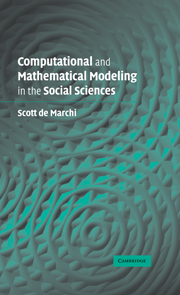Book contents
- Frontmatter
- Contents
- Acknowledgments
- Prelude
- 1 Not All Fun and Games: Challenges in Mathematical Modeling
- 2 Looking for Car Keys Without Any Street Lights
- 3 From Curses to Complexity: The Justification for Computational Modeling
- 4 Why Everything Should Look Like a Nail: Deriving Parsimonious Encodings for Complex Games
- 5 KKV Redux: Deriving and Testing Logical Implications
- 6 A Short Conclusion
- References
- Index
4 - Why Everything Should Look Like a Nail: Deriving Parsimonious Encodings for Complex Games
Published online by Cambridge University Press: 23 July 2009
- Frontmatter
- Contents
- Acknowledgments
- Prelude
- 1 Not All Fun and Games: Challenges in Mathematical Modeling
- 2 Looking for Car Keys Without Any Street Lights
- 3 From Curses to Complexity: The Justification for Computational Modeling
- 4 Why Everything Should Look Like a Nail: Deriving Parsimonious Encodings for Complex Games
- 5 KKV Redux: Deriving and Testing Logical Implications
- 6 A Short Conclusion
- References
- Index
Summary
INTRODUCTION
In this text, there have been a number of models presented, ranging in complexity from the currency game to the alliance game. On the simpler end of things, the currency game (in Chapters 2 and 3) can be implemented with 85 lines of documented Perl code. The alliance game, by contrast, represents a much more significant undertaking. If, in fact, one set out as I did for the currency game, fired up a text editor, and typed in the code without any prior planning, disaster would certainly result. While it may well be the case that Perl would serve for this project, one would need a different paradigm for building a computational model to accommodate the complexities of the alliance game.
The goal of this chapter is to cover some of the material that would allow a researcher who is not an expert in computer science to derive their own computational models for both simple and complex problems. I see this as fundamental to the methodology. If researchers take the alternative route – letting someone who is skilled in computer science derive models for them – there is a high likelihood that the final results will be difficult for the original researcher to interpret or verify, much less an outsider. There are simply too many choices made in the process of coding a model for the primary researcher to be disengaged from the process.
- Type
- Chapter
- Information
- Computational and Mathematical Modeling in the Social Sciences , pp. 113 - 143Publisher: Cambridge University PressPrint publication year: 2005



